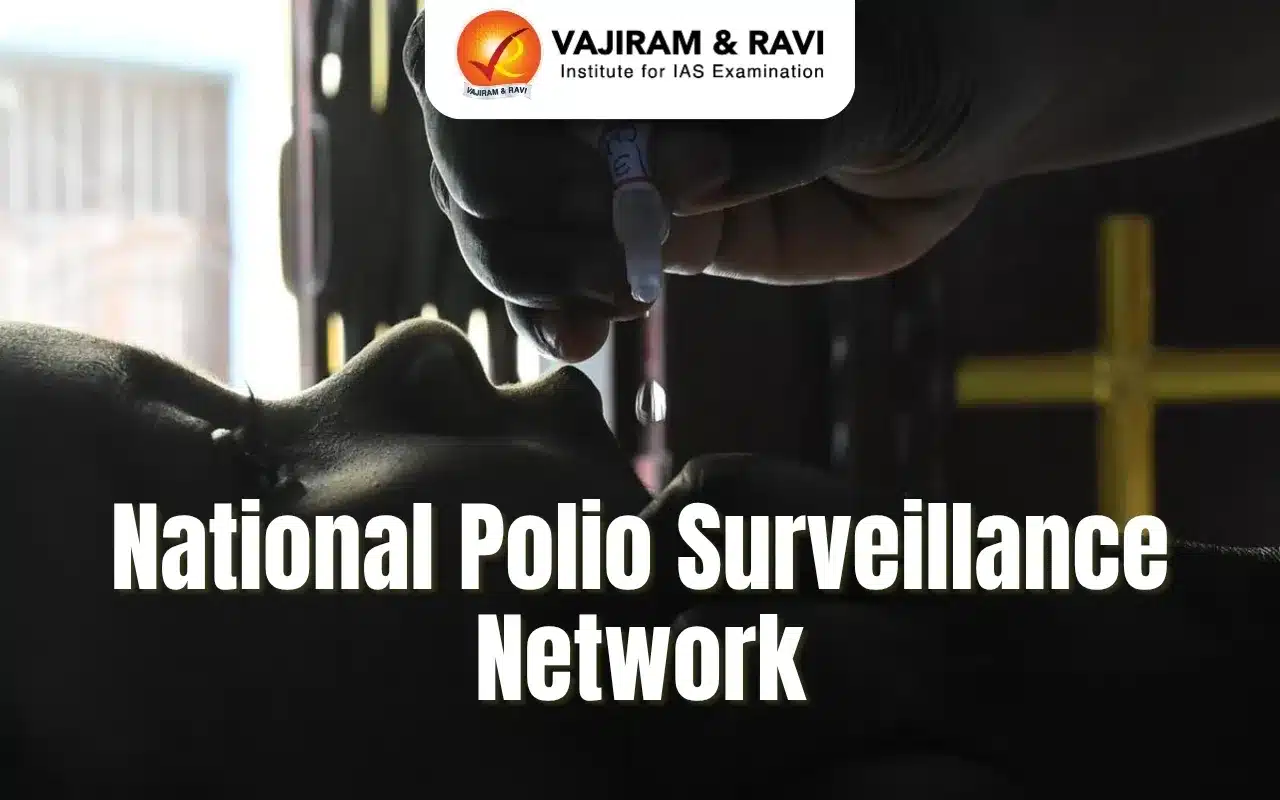National Polio Surveillance Network Transition Latest News
- The government has proposed to wind down, in phases, the World Health Organization (WHO)-established National Polio Surveillance Network (NPSN), currently a countrywide network of over 200 units.
Introduction
- India, having achieved polio-free status in 2014, is now moving to gradually scale down the National Polio Surveillance Network (NPSN), a vast network of field units that played a pivotal role in this milestone.
- The plan, led by the Government of India in collaboration with the World Health Organization (WHO), aims to phase out the network and integrate polio surveillance into broader public health surveillance mechanisms.
- However, public health experts and field staff have raised alarm over the decision, citing continuing polio cases in neighbouring countries, risk of vaccine-derived poliovirus (VDPV) transmission, and the importance of maintaining robust disease surveillance systems.
About the National Polio Surveillance Network (NPSN)
- Established in collaboration with WHO, the NPSN began functioning in the late 1990s to detect, monitor, and eliminate polio from India.
- It includes over 280 surveillance units nationwide and works closely with public health departments, immunization campaigns, and global partners.
- Achievements of NPSN:
- Played a vital role in India being declared polio-free in 2014.
- Detected and responded to poliovirus transmission rapidly, preventing outbreaks.
- Expanded to support surveillance for other vaccine-preventable diseases such as measles, rubella, and DPT.
Phased Drawdown and Transition
- According to a communication from WHO’s representative in India, the NPSN will begin its transition from June 2025.
- The number of functioning units is expected to reduce from:
- 280 in FY 2024-25
- To 190 in FY 2025-26
- And finally 140 by FY 2026-27
- This reduction coincides with a proportional cut in financial support. While the WHO and government officials have clarified that surveillance will not be compromised, the responsibility is expected to shift to the Integrated Disease Surveillance Programme (IDSP).
Expert Concerns on Premature Transition
- Prominent virologists and immunisation experts have warned against such a move at this stage, describing the decision as “horrifying” and “too early” given the global context.
- Key Concerns Raised:
- Proximity to Polio-Endemic Countries: Afghanistan and Pakistan continue to report cases of wild poliovirus.
- Risk of Vaccine-Derived Poliovirus (VDPV): Since India stopped immunisation against type 2 poliovirus in 2016, an importation of VDPV could lead to rapid community transmission.
- Need for Injectable Polio Vaccine (IPV): Experts recommend a phased withdrawal of Oral Polio Vaccine (OPV) after replacing it with IPV for a year to prevent future outbreaks.
Impact on Public Health Workforce
- The surveillance network employs thousands of health workers. Staff members working under Special Services Agreements have expressed apprehension regarding job security.
- Each centre employs around four workers, and with over 200 units scheduled for closure, the drawdown could impact hundreds of livelihoods.
- Additionally, since 2014, the NPSN units have expanded roles beyond polio to include:
- Monitoring measles and rubella outbreaks
- Supporting DPT vaccination campaigns
- Conducting field training for new vaccine rollouts
- Experts fear the dismantling of these units could undermine years of progress in broader immunisation and disease surveillance programs.
Balancing Transition with Vigilance
- The WHO has clarified that the transition will not be abrupt. Units will be retired in phases, allowing government systems to absorb the surveillance duties progressively.
- However, stakeholders insist that India must ensure no gaps emerge in surveillance during this restructuring.
- As India prepares to subsume polio surveillance within IDSP, the effectiveness of this integration remains to be seen. The situation calls for:
- Continued international collaboration and risk assessment.
- Adequate financial and logistical support to the IDSP.
- Transparent roadmap for IPV integration and OPV phase-out.
Conclusion
- The Government’s decision to gradually phase out the National Polio Surveillance Network, though part of a long-term vision to integrate public health monitoring systems, has stirred concern among public health experts.
- Given ongoing polio transmission in nearby countries and the threat of vaccine-derived strains, India must tread cautiously.
- Robust surveillance must continue to prevent any reversal of its hard-earned polio-free status.
National Polio Surveillance Network Transition FAQs
Q1. What is the National Polio Surveillance Network (NPSN)?
Ans. The NPSN is a WHO-established network of over 280 surveillance units across India that helped achieve polio-free status.
Q2. Why is the government planning to wind down the NPSN?
Ans. The government aims to integrate polio surveillance into broader health systems like the Integrated Disease Surveillance Programme.
Q3. What concerns have experts raised about this move?
Ans. Experts warn of premature dismantling due to polio cases in neighboring countries and the risk of vaccine-derived poliovirus outbreaks.
Q4. What roles do NPSN units perform beyond polio monitoring?
Ans. They support surveillance of measles, rubella, DPT, child vaccination, and training of health workers for new vaccine rollouts.
Q5. When will the transition of NPSN units begin?
Ans. The phased transition will start from June 2025 and continue through 2026–27.
Source: TH
Last updated on June, 2025
→ UPSC Notification 2025 was released on 22nd January 2025.
→ UPSC Prelims Result 2025 is out now for the CSE held on 25 May 2025.
→ UPSC Prelims Question Paper 2025 and Unofficial Prelims Answer Key 2025 are available now.
→ UPSC Calendar 2026 is released on 15th May, 2025.
→ The UPSC Vacancy 2025 were released 1129, out of which 979 were for UPSC CSE and remaining 150 are for UPSC IFoS.
→ UPSC Mains 2025 will be conducted on 22nd August 2025.
→ UPSC Prelims 2026 will be conducted on 24th May, 2026 & UPSC Mains 2026 will be conducted on 21st August 2026.
→ The UPSC Selection Process is of 3 stages-Prelims, Mains and Interview.
→ UPSC Result 2024 is released with latest UPSC Marksheet 2024. Check Now!
→ UPSC Toppers List 2024 is released now. Shakti Dubey is UPSC AIR 1 2024 Topper.
→ Also check Best IAS Coaching in Delhi
Tags: mains articles national polios surveillance network transition upsc current affairs upsc mains current affairs
























